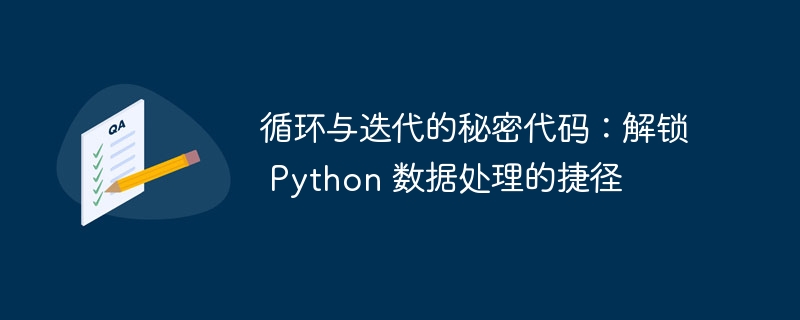 Backend Development
Backend Development
 Python Tutorial
Python Tutorial
 The Secret Code of Loops and Iteration: Unlocking Shortcuts to Python Data Processing
The Secret Code of Loops and Iteration: Unlocking Shortcuts to Python Data Processing
The Secret Code of Loops and Iteration: Unlocking Shortcuts to Python Data Processing

python, loop, iteration, data processing
Loop: Repeat a block of code
Loops are an effective way to repeat a block of code multiple times. Python provides two basic loop types: for and while loops:
- for loop: Used to traverse the elements in a collection , such as a list, tuple or string .
- while loop: Used to execute a block of code as long as the given condition is true.
Code demo:
# for 循环
fruits = ["苹果", "香蕉", "橙子"]
for fruit in fruits:
print(fruit)
# while 循环
count = 0
while count < 5:
print("计数:", count)
count += 1Iteration: Traverse the data collection
Iteration is a process of stepping through the elements of a data collection (such as a list or string). Python provides a variety of built-in iterators, such as list.iter() and str.iter(), for accessing elements in a collection.
Code demo:
# 使用 list.iter() 迭代列表 fruits = ["苹果", "香蕉", "橙子"] fruit_iter = fruits.iter() print(next(fruit_iter))# 输出:苹果 print(next(fruit_iter))# 输出:香蕉 # 使用 str.iter() 迭代字符串 name = "John Smith" name_iter = name.iter() print(next(name_iter))# 输出:J print(next(name_iter))# 输出:o
Combination application of loops and iterations
Loops and iterations are often used together to implement complex data processing tasks. For example, you can use a for loop to iterate over a list, and then use an iterator to access the children of each element.
Code demo:
# 结合 for 循环和 str.iter() 迭代字符串列表
fruits = ["苹果", "香蕉", "橙子"]
for fruit in fruits:
fruit_iter = fruit.iter()
print("第一个字母:", next(fruit_iter))in conclusion
Loops and iterations are powerful data processing tools in Python. By understanding their principles and applying them in real code, you can improve your code efficiency, handle large data sets and unlock more data processing possibilities.
The above is the detailed content of The Secret Code of Loops and Iteration: Unlocking Shortcuts to Python Data Processing. For more information, please follow other related articles on the PHP Chinese website!

Hot AI Tools

Undresser.AI Undress
AI-powered app for creating realistic nude photos

AI Clothes Remover
Online AI tool for removing clothes from photos.

Undress AI Tool
Undress images for free

Clothoff.io
AI clothes remover

Video Face Swap
Swap faces in any video effortlessly with our completely free AI face swap tool!

Hot Article

Hot Tools

Notepad++7.3.1
Easy-to-use and free code editor

SublimeText3 Chinese version
Chinese version, very easy to use

Zend Studio 13.0.1
Powerful PHP integrated development environment

Dreamweaver CS6
Visual web development tools

SublimeText3 Mac version
God-level code editing software (SublimeText3)

Hot Topics
 1386
1386
 52
52
 How to solve the permissions problem encountered when viewing Python version in Linux terminal?
Apr 01, 2025 pm 05:09 PM
How to solve the permissions problem encountered when viewing Python version in Linux terminal?
Apr 01, 2025 pm 05:09 PM
Solution to permission issues when viewing Python version in Linux terminal When you try to view Python version in Linux terminal, enter python...
 How to efficiently copy the entire column of one DataFrame into another DataFrame with different structures in Python?
Apr 01, 2025 pm 11:15 PM
How to efficiently copy the entire column of one DataFrame into another DataFrame with different structures in Python?
Apr 01, 2025 pm 11:15 PM
When using Python's pandas library, how to copy whole columns between two DataFrames with different structures is a common problem. Suppose we have two Dats...
 How to teach computer novice programming basics in project and problem-driven methods within 10 hours?
Apr 02, 2025 am 07:18 AM
How to teach computer novice programming basics in project and problem-driven methods within 10 hours?
Apr 02, 2025 am 07:18 AM
How to teach computer novice programming basics within 10 hours? If you only have 10 hours to teach computer novice some programming knowledge, what would you choose to teach...
 How to avoid being detected by the browser when using Fiddler Everywhere for man-in-the-middle reading?
Apr 02, 2025 am 07:15 AM
How to avoid being detected by the browser when using Fiddler Everywhere for man-in-the-middle reading?
Apr 02, 2025 am 07:15 AM
How to avoid being detected when using FiddlerEverywhere for man-in-the-middle readings When you use FiddlerEverywhere...
 What are regular expressions?
Mar 20, 2025 pm 06:25 PM
What are regular expressions?
Mar 20, 2025 pm 06:25 PM
Regular expressions are powerful tools for pattern matching and text manipulation in programming, enhancing efficiency in text processing across various applications.
 How does Uvicorn continuously listen for HTTP requests without serving_forever()?
Apr 01, 2025 pm 10:51 PM
How does Uvicorn continuously listen for HTTP requests without serving_forever()?
Apr 01, 2025 pm 10:51 PM
How does Uvicorn continuously listen for HTTP requests? Uvicorn is a lightweight web server based on ASGI. One of its core functions is to listen for HTTP requests and proceed...
 What are some popular Python libraries and their uses?
Mar 21, 2025 pm 06:46 PM
What are some popular Python libraries and their uses?
Mar 21, 2025 pm 06:46 PM
The article discusses popular Python libraries like NumPy, Pandas, Matplotlib, Scikit-learn, TensorFlow, Django, Flask, and Requests, detailing their uses in scientific computing, data analysis, visualization, machine learning, web development, and H
 How to dynamically create an object through a string and call its methods in Python?
Apr 01, 2025 pm 11:18 PM
How to dynamically create an object through a string and call its methods in Python?
Apr 01, 2025 pm 11:18 PM
In Python, how to dynamically create an object through a string and call its methods? This is a common programming requirement, especially if it needs to be configured or run...



